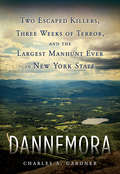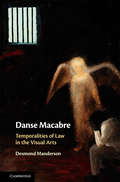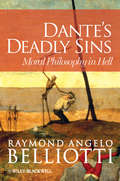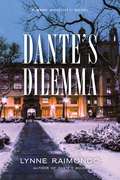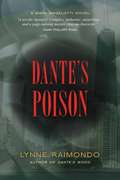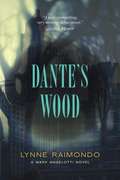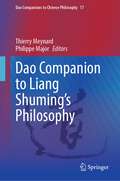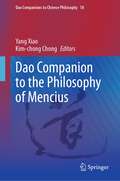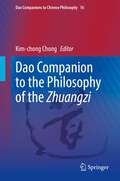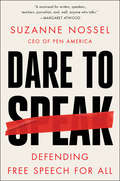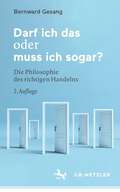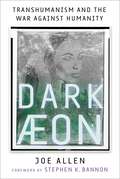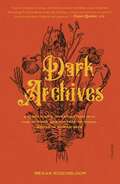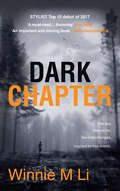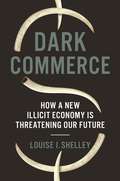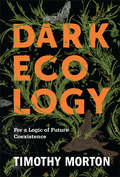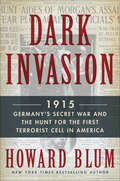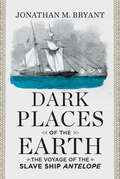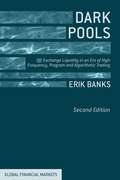- Table View
- List View
Dannemora: Two Escaped Killers, Three Weeks of Terror, and the Largest Manhunt Ever in New York State
by Charles A. GardnerThe Prison Break, the Manhunt, the Inside Story In June 2015, two vicious convicted murderers broke out of the Clinton Correctional Facility in Dannemora, in New York’s North Country, launching the most extensive manhunt in state history. Aided by prison employee Joyce Mitchell, double murderer Richard Matt and cop-killer David Sweat slipped out of their cells, followed a network of tunnels and pipes under the thirty-foot prison wall, and climbed out of a manhole to freedom. For three weeks, the residents of local communities were virtual prisoners in their own homes as law enforcement from across the nation swept the rural wilderness near the Canadian border. The manhunt made front-page headlines—as did the prison sex scandal involving both inmates and Joyce Mitchell—and culminated in a dramatic and bloody standoff. Now Charles A. Gardner—a lifelong resident of the community and a former correction officer who began his training at Clinton and ultimately oversaw the training of staff in twelve prisons, including Clinton—tells the whole story from an insider's point of view. From the lax ethics and sexual hunger that drove Joyce Mitchell to fraternize with Matt and Sweat, smuggle them tools, and offer to be their getaway driver, to the state budget cuts that paved the way for prison corruption, to the brave and tireless efforts to bring the escaped killers to justice, Dannemora is a gripping account of the circumstances that led to the bold breakout and the twenty-three-day search that culminated in one man dead, and one man back in custody—and lingering questions about those who set the deadly drama in motion.
Danse Macabre: Temporalities of Law in the Visual Arts
by Desmond MandersonThe visual arts offer refreshing and novel resources through which to understand the representation, power, ideology and critique of law. This vibrantly interdisciplinary book brings the burgeoning field to a new maturity through extended close readings of major works by artists from Pieter Bruegel and Gustav Klimt to Gordon Bennett and Rafael Cauduro. At each point, the author puts these works of art into a complex dance with legal and social history, and with recent developments in legal and art theory. Manderson uses the idea of time and temporality as a focal point through which to explore how the work of art engages with and constitutes law and human lives. In the symmetries and asymmetries caused by the vibrating harmonic resonances of these triple forces - time, law, art - lies a way of not only understanding the world, but also transforming it.
Dante's Deadly Sins: Moral Philosophy In Hell
by Raymond Angelo BelliottiDante’s Deadly Sins is a unique study of the moral philosophy behind Dante’s master work that considers the Commedia as he intended, namely, as a practical guide to moral betterment. Focusing on Inferno and Purgatorio, Belliotti examines the puzzles and paradoxes of Dante’s moral assumptions, his treatment of the 7 deadly sins, and how 10 of his most powerful moral lessons anticipate modern existentialism. Analyzes the moral philosophy underpinning one of the greatest works of world culture Summarizes the Inferno and Purgatorio, while underscoring their moral implications Explains and evaluates Dante’s understanding of the ‘Seven Deadly Sins’ and the ultimate role they play as the basis of human transgression. Provides a detailed discussion of the philosophical concepts of moral desert and the law of contrapasso, using character case studies within Dante’s work Connects the poem’s moral themes to our own contemporary condition
Dante's Dilemma: A Mark Angelotti Novel (Mark Angelotti)
by Lynne RaimondoBlind psychiatrist Mark Angelotti is faced with his most troubling case yet when he is asked to evaluate Rachel Lazarus, the estranged wife of a slain University of Chicago professor. Months earlier, the professor's body was found stuffed into one of the exhibits at "Scav," the school's world-famous annual scavenger hunt, and - in a feast for the press - missing a vital piece of its anatomy. Though she's confessed to her husband's murder, Rachel is mounting a battered woman's defense. Forced into helping the prosecution, Mark becomes unsure of his objectivity when his investigation uncovers uncomfortable parallels between Rachel's history and his own. That concern proves well-founded when his damaging admission at trial all but convicts Rachel. Then a tip connects the case to another suspected murder and evidence that Rachel may not be guilty after all. As he plows ahead during a brutal Chicago winter, Mark soon learns he has far more to worry about than treacherous snow and ice: someone will do anything to guarantee that Rachel takes the fall. From the Trade Paperback edition.
Dante's Poison: A Mark Angelotti Novel (Mark Angelotti)
by Lynne RaimondoBlind psychiatrist Mark Angelotti has just enrolled in a drug trial that holds out hope of restoring his eyesight when he again becomes entangled in a case that is rocking the Chicago legal community. After defending the manufacturer of the powerful antipsychotic drug Lucitrol against product-liability claims, attorney Jane Barrett has become somewhat of an expert on the controversial medication. So when her lover, investigative journalist Rory Gallagher, collapses from a fatal dose of the same drug, it falls to Hallie Sanchez, Barrett's oldest friend, to defend her on murder charges. Amid growing doubts about her friend's innocence, Hallie recruits Mark Angelotti to help her discredit the testimony of a crucial eyewitness. The pair succeeds in obtaining Barrett's release, but at a dreadful price. Mark sets out to investigate who else may have wanted the journalist out of the way. As he gets closer to the truth, he realizes the killer is still on the loose. But two questions remain for Mark: Will the drug trial succeed in restoring his eyesight? More important, will he live long enough to see this case to its end?From the Trade Paperback edition.
Dante's Wood: A Mark Angelotti Novel (Mark Angelotti)
by Lynne RaimondoA troubled psychiatrist turns investigator when a young patient confesses to murder.Psychiatrist Mark Angelotti knows that genes don't lie. Or do they? Back at work after a devastating illness, Mark believes he has put his past behind him when he is asked to examine Charlie Dickerson, a mentally handicapped teenager whose wealthy mother insists he is a victim of sexual abuse. Mark diagnoses a different reason for Charlie's ills, but his prescription turns deadly when a teacher is murdered and Charlie confesses to the police. Volunteering to testify on Charlie's behalf, Mark's worst fears are realized when paternity tests show the victim was pregnant with Charlie's child. Now it's up to Mark to prove Charlie's innocence in a case where nothing is as first meets the eye. Not even genes-Mark's or Charlie's-can be trusted to shine a light on the truth.
Dao Companion to Liang Shuming’s Philosophy (Dao Companions to Chinese Philosophy #17)
by Thierry Meynard Philippe MajorThis book provides an analysis of the complex philosophy of Liang Shuming. This twentieth-century thinker opened up a number of paths that were to become central components of modern Chinese philosophy. For the first time, experts are brought together to analyze the complexity of his philosophy, which continues to exert a considerable influence today. This edited volume covers Liang’s multifaceted thought as informed by his many identities as a Buddhist, a Confucian, a Bergsonian, a rural reformer, and a philosopher. The volume will appeal to students, scholars, and general-interest readers.
Dao Companion to the Philosophy of Mencius (Dao Companions to Chinese Philosophy #18)
by Yang Xiao Kim-Chong ChongThis book is about the philosophical, historical, and interpretative aspects of Mencius. It explores his influence, reception, and relevance in China from the third century BCE to the present, as well as offers comparative studies of Mencius and major figures in the history of Chinese and Western philosophy. With 34 accessible articles written by leading philosophers and scholars, the Dao Companion to the Philosophy of Mencius provides both broad pictures and in-depth discussions regarding the work of one of the most important and influential Chinese philosophers. It covers his normative ethics, meta-ethics, political philosophy, epistemology and moral psychology. The last section of the volume, “Mencius and Western Philosophers: Comparative Perspectives,” explicitly puts him in dialogue with major Western philosophers. The Dao Companion to the Philosophy of Mencius serves as an essential volume for college students, graduate students, and scholars who study and teach Mencius as well as Chinese philosophy and comparative philosophy in general.
Dao Companion to the Philosophy of the Zhuangzi (Dao Companions to Chinese Philosophy #16)
by Kim-Chong ChongThis comprehensive collection brings out the rich and deep philosophical resources of the Zhuangzi. It covers textual, linguistic, hermeneutical, ethical, social/political and philosophical issues, with the latter including epistemological, metaphysical, phenomenological and cross-cultural (Chinese and Western) aspects. The volume starts out with the textual history of the Zhuangzi, and then examines how language is used in the text. It explores this unique characteristic of the Zhuangzi, in terms of its metaphorical forms, its use of humour in deriding and parodying the Confucians, and paradoxically making Confucius the spokesman for Zhuangzi’s own point of view. The volume discusses questions such as: Why does Zhuangzi use language in this way, and how does it work? Why does he not use straightforward propositional language? Why is language said to be inadequate to capture the “dao” and what is the nature of this dao? The volume puts Zhuangzi in the philosophical context of his times, and discusses how he relates to other philosophers such as Laozi, Xunzi, and the Logicians.
Dare to Speak: Defending Free Speech for All
by Suzanne Nossel"A must read."—Margaret AtwoodA vital, necessary playbook for navigating and defending free speech today by the CEO of PEN America, Dare To Speak provides a pathway for promoting free expression while also cultivating a more inclusive public culture.Online trolls and fascist chat groups. Controversies over campus lectures. Cancel culture versus censorship. The daily hazards and debates surrounding free speech dominate headlines and fuel social media storms. In an era where one tweet can launch—or end—your career, and where free speech is often invoked as a principle but rarely understood, learning to maneuver the fast-changing, treacherous landscape of public discourse has never been more urgent. In Dare To Speak, Suzanne Nossel, a leading voice in support of free expression, delivers a vital, necessary guide to maintaining democratic debate that is open, free-wheeling but at the same time respectful of the rich diversity of backgrounds and opinions in a changing country. Centered on practical principles, Nossel’s primer equips readers with the tools needed to speak one’s mind in today’s diverse, digitized, and highly-divided society without resorting to curbs on free expression.At a time when free speech is often pitted against other progressive axioms—namely diversity and equality—Dare To Speak presents a clear-eyed argument that the drive to create a more inclusive society need not, and must not, compromise robust protections for free speech. Nossel provides concrete guidance on how to reconcile these two sets of core values within universities, on social media, and in daily life. She advises readers how to:Use language conscientiously without self-censoring ideas;Defend the right to express unpopular views;And protest without silencing speech.Nossel warns against the increasingly fashionable embrace of expanded government and corporate controls over speech, warning that such strictures can reinforce the marginalization of lesser-heard voices. She argues that creating an open market of ideas demands aggressive steps to remedy exclusion and ensure equal participation. Replete with insightful arguments, colorful examples, and salient advice, Dare To Speak brings much-needed clarity and guidance to this pressing—and often misunderstood—debate.
Darf ich das oder muss ich sogar?: Die Philosophie des richtigen Handelns
by Bernward GesangOb es um Weltarmut oder um Genfood geht, ob um die Erderwärmung oder die Menschenrechte, ob um Flüchtlingspolitik oder die Verteilung medizinischer Güter, - immer stoßen wir auf drängende Fragen der Moral und ihrer Entscheidung. Dieses Buch bietet keine Patentrezepte für richtiges Handeln, führt aber in alle wichtigen Begriffe und Grundlagen ethischen Denkens und in die Werkzeuge zur Entscheidungsfindung ein. Auf der Basis einer praktisch orientierten utilitaristischen Interessensethik findet der Autor originelle Antworten auf viele wichtige Fragen der Gegenwart.
Daring Escape From Alcatraz (History's Mysteries)
by Matt ChandlerLocated on an island in San Francisco Bay, Alcatraz was once considered one of the country’s most secure prisons. But that didn’t stop three prisoners from making a daring escape the night of June 11, 1962. They set sail across the bay on a homemade raft made of raincoats. Then they vanished. What happened to them? Explore the theories and discover why their escape has become one of history’s greatest mysteries.
Dark Aeon: Transhumanism and the War Against Humanity
by Joe AllenHumanity Is Consumed by Relentless Transformation Like a thief in the night, artificial intelligence has inserted itself into our lives. It makes important decisions for us every day. Often, we barely notice. As Joe Allen writes in this groundbreaking book, &“Transhumanism is the great merger of humankind with the Machine. At this stage in history, it consists of billions using smartphones. Going forward, we&’ll be hardwiring our brains to artificial intelligence systems.&” The world-famous robot, Sophia, symbolizes a rising techno-religion. She takes her name from the goddess—or Aeon—whose fall from grace is described in the Gnostic Gospels. With an academic background in both science and theology, Allen confronts the paradox of what he calls &“good people constructing a digital abomination.&” Dark Aeon is nothing less than a cri de coeur for humanity itself. He takes us on a roller coaster ride through history and the emergence of Scientism, and from government-mandated mRNA vaccines to the weird visions of cyborg billionaires like Elon Musk. From Silicon Valley to China, these globalists&’ visions of humanity&’s future, exposed and described in Dark Aeon, are dire and terrifying. But Joe Allen argues that humanity&’s salvation is within our grasp. Only if we refuse to avert our eyes from the impending twilight before us.
Dark Archives: A Librarian's Investigation into the Science and History of Books Bound in Human Skin
by Megan RosenbloomOn bookshelves around the world, surrounded by ordinary books bound in paper and leather, rest other volumes of a distinctly strange and grisly sort: those bound in human skin. Would you know one if you held it in your hand?In Dark Archives, Megan Rosenbloom seeks out the historic and scientific truths behind anthropodermic bibliopegy—the practice of binding books in this most intimate covering. Dozens of such books live on in the world’s most famous libraries and museums. Dark Archives exhumes their origins and brings to life the doctors, murderers, innocents, and indigents whose lives are sewn together in this disquieting collection. Along the way, Rosenbloom tells the story of how her team of scientists, curators, and librarians test rumored anthropodermic books, untangling the myths around their creation and reckoning with the ethics of their custodianship. A librarian and journalist, Rosenbloom is a member of The Order of the Good Death and a cofounder of their Death Salon, a community that encourages conversations, scholarship, and art about mortality and mourning. In Dark Archives—captivating and macabre in all the right ways—she has crafted a narrative that is equal parts detective work, academic intrigue, history, and medical curiosity: a book as rare and thrilling as its subject.
Dark Bargain: Slavery, Profits, and the Struggle for the Constitution
by Lawrence GoldstoneAn eye-opening examination of America's foundation. On September 17, 1787, at the State House in Philadelphia, thirty-nine men from twelve states, after months of often bitter debate, signed America’s Constitution. Yet very few of the delegates, at the start, had had any intention of creating a nation that would last. Most were driven more by pragmatic, regional interests than by idealistic vision. Many were meeting for the first time, others after years of contention, and the inevitable clash of personalities would be as intense as the advocacy of ideas or ideals. No issue was of greater concern to the delegates than that of slavery: it resounded through debates on the definition of treason, the disposition of the rich lands west of the Alleghenies and the admission of new states, representation and taxation, the need for a national census, and the very make-up of the legislative and executive branches of the new government. As Lawrence Goldstone provocatively makes clear in Dark Bargain, "to a significant and disquieting degree, America’s most sacred document was molded and shaped by the most notorious institution in its history." Goldstone chronicles the forging of the Constitution through the prism of the crucial compromises made by men consumed with the needs of the slave economy. As the daily debates and backroom conferences in inns and taverns stretched through July and August of that hot summer--and as the philosophical leadership of James Madison waned--Goldstone clearly reveals how tenuous the document was, and how an agreement between unlikely collaborators John Rutledge of South Carolina, and Roger Sherman and Oliver Ellsworth of Connecticut--got the delegates past their most difficult point. Dark Bargain recounts an event as dramatic and compelling as any in our nation’s history.
Dark Chapter
by Winnie M. Li'An important and moving book' --Cathy Rentzenbrink'I have never found myself rooting for a heroine with more urgency' --Kate Rhodes'Deftly written, pacey and unflinching, I could not put it down. Winnie Li is a rare talent with an explosive and timely story. Do not miss it.' --Marti Leimbach, best-selling author of Dying Young and Daniel Isn't TalkingHighly Commended for the CWA Debut Dagger 2015Shortlisted for the Emma Humphreys Memorial Prize 2015Shortlisted for the Pat Kavanagh Prize 2015Runner-up in the SI Leeds Literary PrizeVivian is a cosmopolitan Taiwanese-American tourist who often escapes her busy life in London through adventure and travel. Johnny is a 15-year-old Irish teenager, living a neglected life on the margins of society.On a bright spring afternoon in West Belfast, their paths collide during a horrifying act of violence.In the aftermath, each is forced to confront the chain of events that led to the attack.Inspired by true events, this is a story of the dark chapters and chance encounters that can irrevocably determine the shape of our lives. *2018 Edgar Award Best First Novel Nominee
Dark Commerce: How a New Illicit Economy Is Threatening Our Future
by Louise I. ShelleyA comprehensive look at the world of illicit trade Though mankind has traded tangible goods for millennia, recent technology has changed the fundamentals of trade, in both legitimate and illegal economies. In the past three decades, the most advanced forms of illicit trade have broken with all historical precedents and, as Dark Commerce shows, now operate as if on steroids, tied to computers and social media. In this new world of illicit commerce, which benefits states and diverse participants, trade is impersonal and anonymized, and vast profits are made in short periods with limited accountability to sellers, intermediaries, and purchasers.Louise Shelley examines how new technology, communications, and globalization fuel the exponential growth of dangerous forms of illegal trade—the markets for narcotics and child pornography online, the escalation of sex trafficking through web advertisements, and the sale of endangered species for which revenues total in the hundreds of millions of dollars. The illicit economy exacerbates many of the world’s destabilizing phenomena: the perpetuation of conflicts, the proliferation of arms and weapons of mass destruction, and environmental degradation and extinction. Shelley explores illicit trade in tangible goods—drugs, human beings, arms, wildlife and timber, fish, antiquities, and ubiquitous counterfeits—and contrasts this with the damaging trade in cyberspace, where intangible commodities cost consumers and organizations billions as they lose identities, bank accounts, access to computer data, and intellectual property.Demonstrating that illicit trade is a business the global community cannot afford to ignore and must work together to address, Dark Commerce considers diverse ways of responding to this increasing challenge.
Dark Days in Chicago: The Rehabilitation of an Urban Street Terrorist
by Larry L. Franklin Stanley Davis Adolfo Davis Patrick PursleyThe driving force behind this work was a shared commitment to violent ways, and to explore the newfound secrets to a better life. Their desire to help the at-risk youth of Chicago -- the place where street gangs rule -- gave the authors a reason to wake up each morning, a reason to live. Larry Franklin is the author who brought their work to public attention.
Dark Ecology: For a Logic of Future Coexistence (The Wellek Library Lectures)
by Timothy MortonTimothy Morton argues that ecological awareness in the present Anthropocene era takes the form of a strange loop or Möbius strip, twisted to have only one side. Deckard travels this oedipal path in Blade Runner (1982) when he learns that he might be the enemy he has been ordered to pursue. Ecological awareness takes this shape because ecological phenomena have a loop form that is also fundamental to the structure of how things are.The logistics of agricultural society resulted in global warming and hardwired dangerous ideas about life-forms into the human mind. Dark ecology puts us in an uncanny position of radical self-knowledge, illuminating our place in the biosphere and our belonging to a species in a sense that is far less obvious than we like to think. Morton explores the logical foundations of the ecological crisis, which is suffused with the melancholy and negativity of coexistence yet evolving, as we explore its loop form, into something playful, anarchic, and comedic. His work is a skilled fusion of humanities and scientific scholarship, incorporating the theories and findings of philosophy, anthropology, literature, ecology, biology, and physics. Morton hopes to reestablish our ties to nonhuman beings and to help us rediscover the playfulness and joy that can brighten the dark, strange loop we traverse.
Dark Ghettos
by Tommie ShelbyFor Tommie Shelby, the persistence of ghettos raises many thorny questions of morality, and he offers practical answers framed in terms of what justice requires of government and its citizens. His social vision and political ethics calls for putting the abolition of ghettos at the center of reform.
Dark Invasion
by Howard BlumWhat happens when German spies collaborate to unleash a campaign of terror upon America at the start of World War I?In the summer of 1914, New York Police Department captain Tom Tunney is preoccupied by Manhattan's raging gang rivalries and has little idea that, halfway around the world, a much more ominous threat to the city is brewing. As Germany teeters on the brink of war, its ambassador to the United States is given instructions to find and finance a team of undercover saboteurs who can bring America to its knees before it has a chance to enter the conflict on the side of the Allies.At the page-turning pace of a spy thriller, Dark Invasion tells the remarkable true story of Tunney and his pivotal role in discovering, and delivering to justice, a ruthless ring of German terrorists determined to annihilate the United States. Overwhelmed and undermatched, Tunney's small squad of cops was the David to Germany's Goliath, the operatives of which included military officers, a germ warfare expert, a gifted Harvard professor, a bomb technician, and a document forger. As explosions leveled munitions plants and destroyed cargo ships, particularly in and around New York City, pan- icked officials talked about rogue activists and anarchists--but it was Tunney who suspected that these incidents were part of something bigger and became determined to bring down the culprits.Through meticulous research, Blum deftly reconstructs an enthralling, vividly detailed saga of subterfuge and bravery. Enhanced by more than fifty images sourced from global archives, his gritty, energetic narrative follows the German spies--with Tunney hot on their heels--from the streets, harbors, and warehouses of New York City to the genteel quads of Harvard, the grand estates of industry tycoons, and the steps of the U.S. Capitol. The New York Police Department's breathtaking efforts to unravel the extent of the German plot and close in on its perpetrators are revealed in this riveting account of America's first encounter with a national security threat unlike any other--the threat of terrorism--that is more relevant now than ever.
Dark Justice (The Ben Kincaid Novels #8)
by William BernhardtA lawyer defends an animal rights activist accused of killing a lumberjack: &“[A] superb legal thriller [and] wonderfully riveting read&” (Booklist). The trouble all begins when Ben Kincaid meets Margery. Kincaid is a lawyer on a book tour, at a poorly attended signing in Washington state, and she is the bookseller&’s cat. When he learns that the perfectly healthy cat is to be euthanized, Kincaid breaks into the bookstore, planning a rescue. Instead, he lands himself in jail, where he learns of a non-feline who&’s facing the death penalty as well. George Zakin is the head of a radical environmentalist organization called Green Rage. Six years earlier, Kincaid got him acquitted on charges of breaking and entering, and now Zakin needs his help again. He has been accused of planting a bomb that killed a lumberjack, and Kincaid will do whatever he can to save the environmentalist&’s neck—if he can get himself out of jail first.
Dark Matters: Pessimism and the Problem of Suffering
by Mara van der LugtAn intellectual history of the philosophers who grappled with the problem of evil, and the case for why pessimism still holds moral value for us todayIn the seventeenth and eighteenth centuries, philosophers engaged in heated debates on the question of how God could have allowed evil and suffering in a creation that is supposedly good. Dark Matters traces how the competing philosophical traditions of optimism and pessimism arose from early modern debates about the problem of evil, and makes a compelling case for the rediscovery of pessimism as a source for compassion, consolation, and perhaps even hope.Bringing to life one of the most vibrant eras in the history of philosophy, Mara van der Lugt discusses legendary figures such as Leibniz, Hume, Voltaire, Rousseau, Kant, and Schopenhauer. She also introduces readers to less familiar names, such as Bayle, King, La Mettrie, and Maupertuis. Van der Lugt describes not only how the earliest optimists and pessimists were deeply concerned with finding an answer to the question of the value of existence that does justice to the reality of human suffering, but also how they were fundamentally divided over what such an answer should look like.A breathtaking work of intellectual history by one of today's leading scholars, Dark Matters reveals how the crucial moral aim of pessimism is to find a way of speaking about suffering that offers consolation and does justice to the fragility of life.
Dark Places of the Earth: The Voyage of the Slave Ship Antelope
by Jonathan M. BryantA dramatic work of historical detection illuminating one of the most significant--and long forgotten--Supreme Court cases in American history. In 1820, a suspicious vessel was spotted lingering off the coast of northern Florida, the Spanish slave ship Antelope. Since the United States had outlawed its own participation in the international slave trade more than a decade before, the ship's almost 300 African captives were considered illegal cargo under American laws. But with slavery still a critical part of the American economy, it would eventually fall to the Supreme Court to determine whether or not they were slaves at all, and if so, what should be done with them. Bryant describes the captives' harrowing voyage through waters rife with pirates and governed by an array of international treaties. By the time the Antelope arrived in Savannah, Georgia, the puzzle of how to determine the captives' fates was inextricably knotted. Set against the backdrop of a city in the grip of both the financial panic of 1819 and the lingering effects of an outbreak of yellow fever, Dark Places of the Earth vividly recounts the eight-year legal conflict that followed, during which time the Antelope's human cargo were mercilessly put to work on the plantations of Georgia, even as their freedom remained in limbo. When at long last the Supreme Court heard the case, Francis Scott Key, the legendary Georgetown lawyer and author of "The Star Spangled Banner," represented the Antelope captives in an epic courtroom battle that identified the moral and legal implications of slavery for a generation. Four of the six justices who heard the case, including Chief Justice John Marshall, owned slaves. Despite this, Key insisted that "by the law of nature all men are free," and that the captives should by natural law be given their freedom. This argument was rejected. The court failed Key, the captives, and decades of American history, siding with the rights of property over liberty and setting the course of American jurisprudence on these issues for the next thirty-five years. The institution of slavery was given new legal cover, and another brick was laid on the road to the Civil War. The stakes of the Antelope case hinged on nothing less than the central American conflict of the nineteenth century. Both disquieting and enlightening, Dark Places of the Earth restores the Antelope to its rightful place as one of the most tragic, influential, and unjustly forgotten episodes in American legal history.
Dark Pools
by Erik BanksDark Pools is a practical text dealing with the increasingly important topic of dark pools, or non-displayed, off-exchange trading and liquidity. A growing amount of institutional trading occurs away from exchanges and expansion in this little understood sector of the market is set to continue. The book is organized in three parts: Market Structure, Micro Issues, and Environment of the Future. The first chapters consider the development and evolution of the equity trading marketplace over the past two decades, including the creation of dedicated dark pool platforms, and introduce the concept of market liquidity, the formation of displayed and non-displayed orders, and the operation and structure of key dark pools. Attention then turns to the architecture of a typical dark pool, and how orders are routed to capture dimensions of non-displayed liquidity. This is followed by an analysis of the pricing and economics of dark liquidity and common trading strategies employed by institutions - including dark algorithms, high frequency trading and the controversial mechanism of 'gaming. ' The final chapters analyze the regulatory and control framework and consider how dark pools may evolve in a post-financial crisis world.
